Related Research Articles

Arriva Trains Wales was a British train operating company owned by Arriva UK Trains that operated the Wales & Borders franchise. It ran urban and inter-urban passenger services to all railway stations in Wales, including Cardiff Central, Cardiff Queen Street, Newport, Swansea, Wrexham General and Holyhead, as well as to certain stations in England such as Hereford, Shrewsbury, Chester, Crewe, Manchester Piccadilly and Birmingham New Street.

J D Wetherspoon plc is a pub company operating in the United Kingdom and Ireland. The company was founded in 1979 by Tim Martin and is based in Watford. It operates the sub-brand of Lloyds No.1 bars, and around 50 Wetherspoon hotels. Wetherspoon is known for converting unconventional premises, such as former cinemas and banks, into pubs. The company is publicly listed on the London Stock Exchange and is a constituent of the FTSE 250 Index.

North Wales is a region of Wales, encompassing its northernmost areas. It borders Mid Wales to the south, England to the east, and the Irish Sea to the north and west. The area is highly mountainous and rural, with Snowdonia National Park and the Clwydian Range and Dee Valley, known for its mountains, waterfalls and trails, wholly within the region. Its population is concentrated in the north-east and northern coastal areas, with significant Welsh-speaking populations in its western and rural areas. North Wales is imprecisely defined, lacking any exact definition or administrative structure. It is commonly defined administratively as its six most northern principal areas, but other definitions exist, with Montgomeryshire historically considered to be part of the region.
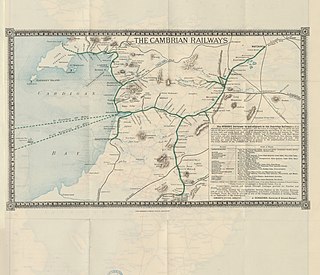
The Cambrian Railways owned 230 miles (370 km) of track over a large area of mid Wales. The system was an amalgamation of a number of railways that were incorporated in 1864, 1865 and 1904. The Cambrian connected with two larger railways with connections to the northwest of England via the London and North Western Railway, and the Great Western Railway for connections between London and Wales. The Cambrian Railways amalgamated with the Great Western Railway on 1 January 1922 as a result of the Railways Act 1921. The name is continued today in the route known as the Cambrian Line.
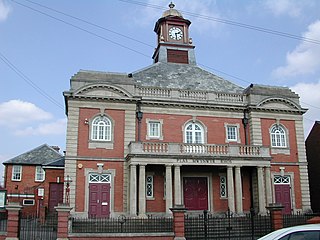
Rhosllanerchrugog is a village and community in Wrexham County Borough, Wales. It lies within the historic county of Denbighshire. The entire built-up area including Penycae, Ruabon and Cefn Mawr had a population of 25,362.

The Welsh Marches line, known historically as the North and West Route, is the railway line running from Newport in south-east Wales to Shrewsbury in the West Midlands region of England by way of Abergavenny, Hereford and Craven Arms and thence to Crewe via Whitchurch. The line thus links the south of Wales to north-west England via the Welsh Marches region, bypassing Birmingham. Through services from south-west Wales, Swansea and Cardiff to Manchester and from Cardiff to Wrexham, Chester, the north coast of Wales and Anglesey constitute the bulk of passenger operations on the route.
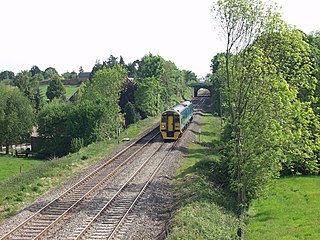
The Shrewsbury–Chester line is a railway line between Chester and Shrewsbury in England, with the line passing through Wrexham County Borough in Wales. Passenger train services are operated by Transport for Wales Rail between the northern terminal of Chester and Shrewsbury in the south as part of the Wales & Borders franchise. Some additional services, starting part way along the line to London Euston via Chester are operated by Avanti West Coast. The line was built in 1846 by the Shrewsbury and Chester Railway, with the engineer for the line being Henry Robertson, a partner in locomotive builders Beyer Peacock, while the contractor was Thomas Brassey in partnership with William Mackenzie and Robert Stephenson. The line is part of Transport for Wales' North Wales Metro improvement programme.

Transport in Wales is heavily influenced by the country's geography. Wales is predominantly hilly or mountainous, and the main settlements lie on the coasts of north and south Wales, while mid Wales and west Wales are lightly populated. The main transport corridors are east–west routes, many continuing eastwards into England.
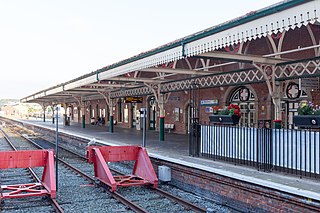
Aberystwyth railway station is a railway station in the town of Aberystwyth, Ceredigion, Wales. It is served by passenger trains operated by Transport for Wales: it is the terminus of the Cambrian Line 81+1⁄2 miles (131.2 km) west of Shrewsbury. It is also the terminus of the narrow-gauge Vale of Rheidol Railway.
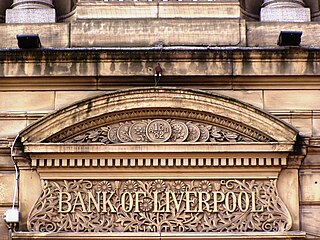
The Bank of Liverpool was a financial institution founded in 1831 in Liverpool, England.
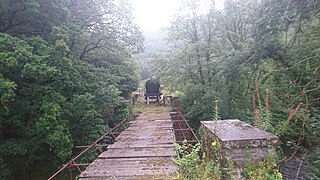
The Carmarthen–Aberystwyth line was originally a standard-gauge branch line of the Great Western Railway (GWR) in Wales, connecting Carmarthen and Aberystwyth.
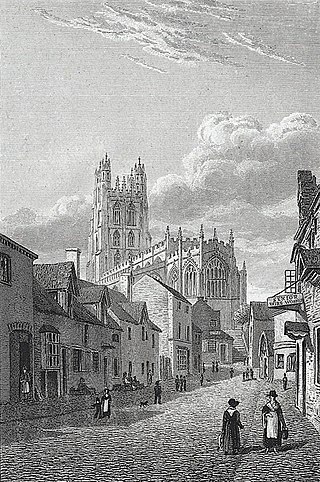
The city of Wrexham in north-east Wales has a history dating back to ancient times. The former market town was the site of heavy industry in the 19th and 20th centuries, and is now an active commercial centre. Wrexham was granted city status in 2022.

The Manchester and Liverpool District Bank was formed in 1829 and it became one of the leading provincial joint stock banks; its name was shortened to District Bank in 1924. The Bank was acquired by the National Provincial Bank in 1962 but kept its identity until the latter’s merger with Westminster Bank.

Aberystwyth is a university and seaside town as well as a community in Ceredigion, Wales. Located in the historic county of Cardiganshire, Aberystwyth means "the mouth of the Ystwyth". Aberystwyth University has been a major educational location in Wales since the establishment of University College Wales in 1872.
The bank officially known as the Aberystwith and Tregaron Bank was established at Aberystwyth, Cardiganshire in the beginning of the 19th century and was locally known as ‘Banc y Ddafad Ddu’, because the bank notes were imprinted with an engraving of a black sheep. The Bank later established a branch at Tregaron.
Bank y Llong was a Welsh bank. It got its name from an engraving of a ship decorating its bank notes. It was probably the first bank in Aberystwyth and was founded soon after the removal of the Custom House from Aberdyfi to Aberystwyth, around 1762.

The building at 155–158 North Street in Brighton, part of the English coastal city of Brighton and Hove, was built between 1921 and 1923 as a branch of National Provincial Bank. The King Louis-style bank was built on the site of several shops. The properties were acquired by the National Provincial Bank during 1916–20. The Brighton Gazette had occupied 155a North Street since 1910, when its long-time home at number 150 was converted into the Cinema de Luxe. Published by William James Towner, the paper’s full title was the Brighton Gazette, Hove Post and Sussex Telegraph. In 2011 it became J D Wetherspoon's second pub in central Brighton. One of many buildings by the prolific local architecture firm of Clayton & Black, whose work in various styles can be found across the city, it forms an important component of the range of banks, offices and commercial buildings on North Street—a significant commercial thoroughfare since the 18th century. In particular, the "good attention to detail" shown throughout the building's Louis XIV-style façade has been praised. English Heritage has listed it at Grade II for its architectural and historical importance.
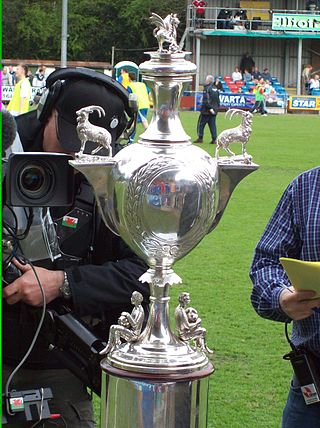
The 1882–83 FAW Welsh Cup was the sixth edition of the annual knockout tournament for competitive football teams in Wales.

A national football museum dedicated to Welsh association football in Wrexham has been proposed by various politicians in both the Welsh Government and local councils, with Wrexham County Borough Council being the leading contender for a museum due to Wrexham's football heritage. The museum is currently in the planning stages and under current proposals, the museum is set to be within the pre-existing County Buildings on Regent Street, in Wrexham's city centre, alongside the Wrexham County Borough Museum and Archives.

The North and South Wales Bank is a former bank and pub in Wrexham city centre, Wales. Located at the eastern end of Wrexham's High Street, it opened in 1912 as the Midland Bank, which purchased the original client The North and South Wales Bank a few years prior to construction. The building is a Grade II listed building.
References
- 1 2 3 4 5 6 7 8 9 10 11 12 13 14 15 16 17 18 19 "The North and South Wales Bank 1836-1908, the 150th anniversary of Midland Bank's forerunners in Wales" (PDF).
- ↑ Morgan, T.O., (1848), New Guide to Aberystwyth and its Environs, mentioned, p. 13
- ↑ Aberystwyth Observer, 9.1.1864
- ↑ Anon, (1874), Morgan's New Guide to Aberystwyth and Neighbourhood, p. 16
- ↑ Samuel, David, Cambrian News, 5.6.1903
- ↑ "The Buildings of Wrexham, High Street, north side". Archived from the original on 2019-04-06. Retrieved 2019-06-15.
- ↑ "J D Wetherspoon: The North and South Wales Bank".
- ↑ "Rhyl History Club: The North and South Wales Bank".
- ↑ "Llangollen: The North and South Wales Bank".
- 1 2 3 "The Telegraph: Wales should have its own banknotes again".